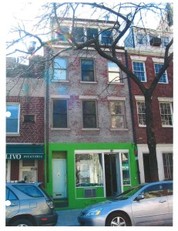186 Spring Street (1824-2012)
Introduction
Text-to-speech Audio
Constructed in 1824, this house was one of the oldest remaining buildings in Greenwich Village and home to several gay-rights activists who lived and worked out of this building in the 1970s and 1980s. The home was known as a "gay commune" following the 1969 Stonewall Rebellion and it was here where Bruce Voeller and other residents lived and worked. The men who lived here were the guiding force in establishing important civil rights organization such as The National Gay and Lesbian Task Force and The Gay and Lesbian Alliance Against Defamation. The property was later owned by the Beastie Boys’ Adam Horovitz. Despite the efforts of historians, local residents, preservationists, and LGBTQ activists in the early 2010s, the property was demolished in 2012 to create room for a seven-story condo unit.
Images
The 190-year old building was demolished in 2012. Photo from Greenwich Village Society for Historic Preservation

Backstory and Context
Text-to-speech Audio
During the 1970s and 1980s, gay rights activists lived and worked out of this townhome. Activists who lived and/or met here went on to establish the Gay and Lesbian Alliance Against Defamation, the Gay Activists Alliance, and the National Gay and Lesbian Task Force. According to the executive director of the Greenwich Village Society for Historic Preservation, these three men lived here and their house also "functioned as a communal space for discussions around the activist issues of the time."
Scientist Bruce Voeller lived at this home at the time of his then-ground-breaking research and public awareness campaign showing that condoms could prevent the spread of AIDS. While he lived at this address, Voeller challenged numerous homophobic and pseudo-scientific theories about the causes of AIDS at a time when some physicians and journalists referred to the disease as "Gay Related Immune Deficiency Disorder. Voeller died of AIDS in 1994.
The property was also home to Jim Owles, who became New York's first openly-gay candidate for a public office. Owles was a leader in the organization of the Gay Activists Alliance and the Gay and Lesbian Alliance Against Defamation. Owles died of AIDS in 1993.
Professor Arnie Kantrowitz also lived at the home and in addition to teaching some of the first courses on homosexuality and literature, he was also one of the first openly gay speakers and activists to appear on nationally syndicated radio and television programs. He was a founder of the Gay and Lesbian Alliance Against Defamation. Kantrowitz authored Under the Rainbow: Growing Up Gay, one of the first and most influential autobiographical looks at life for gay rights activists.
Voeller also challenged the American Psychiatric Association's classification of homosexuality as a mental disorder and launched a successful legal challenge that ended laws that barred gay men from having access to their children. In 1973, responding to activists who lived at this home and the members of the organizations they led, the American Psychiatric Association polled its members for their opinion as to whether homosexuality should continue to be listed in the Diagnostic and Statistical Manual of Mental. Disorders. At that time, 5,854 psychiatrists voted to remove homosexuality from the DSM, and 3,810 to retain it. The APA responded by removing homosexuality from the list of diseases. At the same time, the APA referred to homosexuality as a "disturbance" for people "in conflict" with their sexual orientation.
Scientist Bruce Voeller lived at this home at the time of his then-ground-breaking research and public awareness campaign showing that condoms could prevent the spread of AIDS. While he lived at this address, Voeller challenged numerous homophobic and pseudo-scientific theories about the causes of AIDS at a time when some physicians and journalists referred to the disease as "Gay Related Immune Deficiency Disorder. Voeller died of AIDS in 1994.
The property was also home to Jim Owles, who became New York's first openly-gay candidate for a public office. Owles was a leader in the organization of the Gay Activists Alliance and the Gay and Lesbian Alliance Against Defamation. Owles died of AIDS in 1993.
Professor Arnie Kantrowitz also lived at the home and in addition to teaching some of the first courses on homosexuality and literature, he was also one of the first openly gay speakers and activists to appear on nationally syndicated radio and television programs. He was a founder of the Gay and Lesbian Alliance Against Defamation. Kantrowitz authored Under the Rainbow: Growing Up Gay, one of the first and most influential autobiographical looks at life for gay rights activists.
Voeller also challenged the American Psychiatric Association's classification of homosexuality as a mental disorder and launched a successful legal challenge that ended laws that barred gay men from having access to their children. In 1973, responding to activists who lived at this home and the members of the organizations they led, the American Psychiatric Association polled its members for their opinion as to whether homosexuality should continue to be listed in the Diagnostic and Statistical Manual of Mental. Disorders. At that time, 5,854 psychiatrists voted to remove homosexuality from the DSM, and 3,810 to retain it. The APA responded by removing homosexuality from the list of diseases. At the same time, the APA referred to homosexuality as a "disturbance" for people "in conflict" with their sexual orientation.
Sources
Davis, Amanda. LGBT History and 186 Spring Street. Greenwich Village Society for Historic Preservation. April 18, 2012. Accessed June 23, 2018. http://gvshp.org/blog/2012/07/18/lgbt-history-and-186-spring-street/.
Burton, Neel. When Homosexuality Stopped Being a Mental Disorder. Psychology Today. September 18, 2015. Accessed June 23, 2018. https://www.psychologytoday.com/us/blog/hide-and-seek/201509/when-homosexuality-stopped-being-mental....
Dunlap, David W.. Behind Those Old Bricks on Spring Street, Memories of a 1970s Gay Hub. New York Times. July 18, 2012. Accessed June 23, 2018. https://cityroom.blogs.nytimes.com/2012/07/18/behind-those-old-bricks-on-spring-street-memories-of-a-1970s-gay-hub/.
Burton, Neel. When Homosexuality Stopped Being a Mental Disorder. Psychology Today. September 18, 2015. Accessed June 23, 2018. https://www.psychologytoday.com/us/blog/hide-and-seek/201509/when-homosexuality-stopped-being-mental....
Dunlap, David W.. Behind Those Old Bricks on Spring Street, Memories of a 1970s Gay Hub. New York Times. July 18, 2012. Accessed June 23, 2018. https://cityroom.blogs.nytimes.com/2012/07/18/behind-those-old-bricks-on-spring-street-memories-of-a-1970s-gay-hub/.
